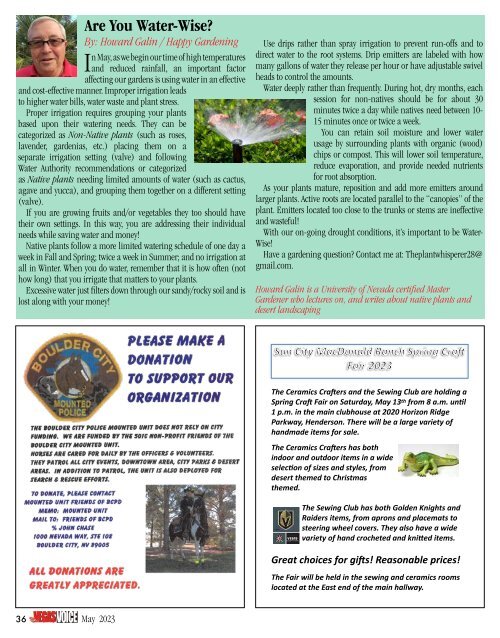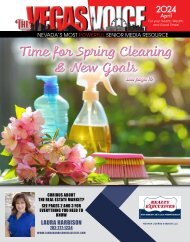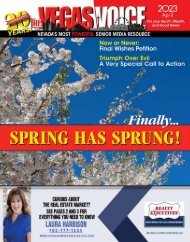Create successful ePaper yourself
Turn your PDF publications into a flip-book with our unique Google optimized e-Paper software.
Are You Water-Wise?<br />
By: Howard Galin / Happy Gardening<br />
In <strong>May</strong>, as we begin our time of high temperatures<br />
and reduced rainfall, an important factor<br />
affecting our gardens is using water in an effective<br />
and cost-effective manner. Improper irrigation leads<br />
to higher water bills, water waste and plant stress.<br />
Proper irrigation requires grouping your plants<br />
based upon their watering needs. They can be<br />
categorized as Non-Native plants (such as roses,<br />
lavender, gardenias, etc.) placing them on a<br />
separate irrigation setting (valve) and following<br />
Water Authority recommendations or categorized<br />
as Native plants needing limited amounts of water (such as cactus,<br />
agave and yucca), and grouping them together on a different setting<br />
(valve).<br />
If you are growing fruits and/or vegetables they too should have<br />
their own settings. In this way, you are addressing their individual<br />
needs while saving water and money!<br />
Native plants follow a more limited watering schedule of one day a<br />
week in Fall and Spring; twice a week in Summer; and no irrigation at<br />
all in Winter. When you do water, remember that it is how often (not<br />
how long) that you irrigate that matters to your plants.<br />
Excessive water just filters down through our sandy/rocky soil and is<br />
lost along with your money!<br />
Use drips rather than spray irrigation to prevent run-offs and to<br />
direct water to the root systems. Drip emitters are labeled with how<br />
many gallons of water they release per hour or have adjustable swivel<br />
heads to control the amounts.<br />
Water deeply rather than frequently. During hot, dry months, each<br />
session for non-natives should be for about 30<br />
minutes twice a day while natives need between 10-<br />
15 minutes once or twice a week.<br />
You can retain soil moisture and lower water<br />
usage by surrounding plants with organic (wood)<br />
chips or compost. This will lower soil temperature,<br />
reduce evaporation, and provide needed nutrients<br />
for root absorption.<br />
As your plants mature, reposition and add more emitters around<br />
larger plants. Active roots are located parallel to the “canopies” of the<br />
plant. Emitters located too close to the trunks or stems are ineffective<br />
and wasteful!<br />
With our on-going drought conditions, it’s important to be Water-<br />
Wise!<br />
Have a gardening question? Contact me at: Theplantwhisperer28@<br />
gmail.com.<br />
Howard Galin is a University of Nevada certified Master<br />
Gardener who lectures on, and writes about native plants and<br />
desert landscaping<br />
Sun City MacDonald Ranch Spring Cra,<br />
Fair <strong>2023</strong><br />
The Ceramics Cra,ers and the Sewing Club are holding a<br />
Spring Cra, Fair on Saturday, <strong>May</strong> 13 th from 8 a.m. unAl<br />
1 p.m. in the main clubhouse at 2020 Horizon Ridge<br />
Parkway, Henderson. There will be a large variety of<br />
handmade items for sale.<br />
The Ceramics Cra,ers has both<br />
indoor and outdoor items in a wide<br />
selecAon of sizes and styles, from<br />
desert themed to Christmas<br />
themed.<br />
The Sewing Club has both Golden Knights and<br />
Raiders items, from aprons and placemats to<br />
steering wheel covers. They also have a wide<br />
variety of hand crocheted and kniLed items.<br />
Great choices for gi,s! Reasonable prices!<br />
The Fair will be held in the sewing and ceramics rooms<br />
located at the East end of the main hallway.<br />
36<br />
<strong>May</strong> <strong>2023</strong>
















